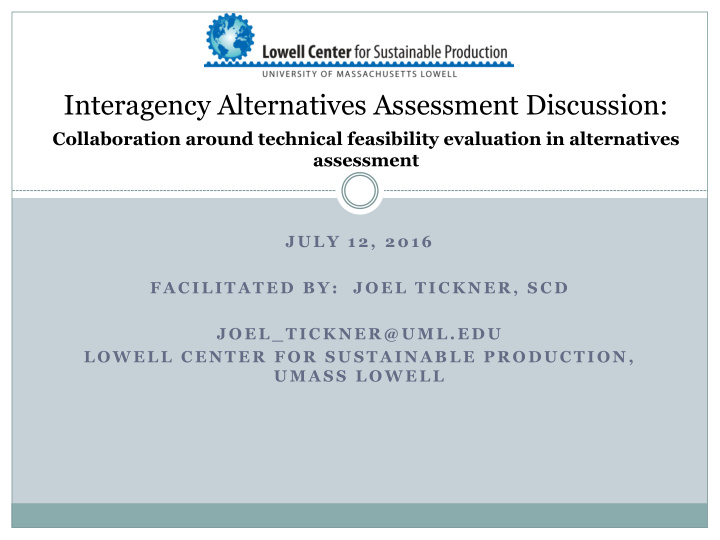



Interagency Alternatives Assessment Discussion: Collaboration around technical feasibility evaluation in alternatives assessment J U L Y 1 2 , 2 0 1 6 F A C I L I T A T E D B Y : J O E L T I C K N E R , S C D J O E L _ T I C K N E R @ U M L . E D U L O W E L L C E N T E R F O R S U S T A I N A B L E P R O D U C T I O N , U M A S S L O W E L L
Goals Continuing education and dialog To advance efforts towards informed substitution and the transition to safer chemicals across federal, state, local and international agencies through networking, sharing of experiences, development of common approaches, tools, datasets, and creation of a community of practice.
Purpose of this call • March Interagency Workshop – five specific areas for next step collaboration: • Coordinated approaches for chemical ingredient disclosure/reporting • Improved economic assessment to support informed substitution • Integrating consideration of safer alternatives into sustainability standards and purchasing • Developing a roadmap for interagency efforts to support the transition to safer chemicals • Advancing coordinated performance evaluation processes
Background Performance assessment is a critical, but often undervalued part of alternatives assessment processes It is a clear challenge to the adoption of safer alternatives Performance evaluation tends to be function/use specific and hard to generalize We will outline the needs for enhanced evaluation of technical feasibility in alternatives assessment processes and some models for industry/government collaboration around performance testing.
Speakers Paul Yaroschak, DoD Greg Morose, MA Toxics Use Reduction Institute
Discussion Questions What are options for enhanced interagency collaboration in performance evaluation for alternatives to chemicals of concern, including the roles of interagency collaboration in forming testing consortia, conducting actual testing, and establishing joint performance requirements? What are next steps to continue this discussion?
Webinar Discussion Instructions Due to the number of participants on the Webinar, all lines will be muted. If you wish to add to the discussion, please type your question in the Q&A box located in the control panel on the side of your screen or use the raise hand button and we will unmute your phone
Performance Evaluation for Alternatives Assessment: Collaboration Model Greg Morose Toxics Use Reduction Institute University of Massachusetts Lowell July 12, 2016
Industry Collaborative Alternatives Assessment Initiatives Lead Reduction for Electronics Industry Collaborative performance testing for safer alternatives to lead in electronics. 2001 to 2009 http://www.turi.org/Our_Work/Business/Industry_Sectors/Electronics Hex Chrome Reduction for Aerospace/Defense Industry Collaborative performance testing for safer alternatives to hex chrome free in aerospace/defense applications. 2012 – ongoing DRAFT http://www.turi.org/Our_Work/Business/Industry_Sectors/Aerospace_Defense
TURI Collaboration Approach 1. Use of a toxic chemical(s) of concern is pervasive in an industry sector 2. Toxic chemical is not used for competitive advantage 3. Strong market and/or regulatory drivers to reduce the use of the toxic chemical 4. Significant research required to switch to the use of safer alternatives 5. Time and cost intensive for companies to individually conduct research 6. Independent third party available to manage and coordinate the effort 7. Voluntary participation by government, academic, and industry collaborators 8. Participants provide either in-kind contributions (production equipment, technical expertise, materials, supplies, testing, etc.) or direct funding 9. Intent of participants is to adopt the safer alternative solutions identified 10. All results made public so that other companies can adopt solutions identified DRAFT 10
Lead in Electronics Products Toxic Chemical of Lead Concern Use Solder, solder paste, board surface finish, component surface finish Quantity Used (prior to 80 – 90 million pounds used globally project start) on an annual basis Driver EU Directive: Restriction on the Use of Certain Hazardous Substances (RoHS) Research Required Technical performance of alternatives for assembly, rework, and long term reliability Collaborative Research Formation of the New England Lead- Approach free Electronics Consortium Alternative Materials Tin, copper, silver, gold DRAFT 11
New England Lead-free Electronics Consortium $1.5 million total in direct funding and in-kind contributions Academia Government Pull testing Funding Statistical analysis Outreach Project mngmt Industry 2001 – 2009 Technical expertise 20+ companies in the Four Phases of Funding, and In-kind electronics industry contributions Research DRAFT 12
Hex Chrome in Aerospace/Defense Toxic Chemical of Hexavalent chromium Concern Project Phases 1) Primers/sealants, 2) sealants, 3) structural adhesive coatings Driver Defense Federal Acquisition Regulation Supplement (DFARS) , May 2011 Research Required Technical performance (corrosion resistance) of alternatives for long term reliability Collaborative Research Formation of the Hex Chrome Free Approach Sealant Evaluation Team for Phases 1, 2, and NASA TEERM Project for Phase 3 Alternative Materials zinc phosphate, ammonium phosphite, molybdates DRAFT 13 13
Hex Chrome Free Sealant Evaluation Team Academia Government Customer Statistical analysis requirements Project mngmt Industry Technical expertise Funding, and In-kind contributions 14
Phase I Test Vehicle Aluminum plates: 2” x 4.5” x 0.25” (alloys 6061 and 7075) 8 stainless steel fasteners (4 with 100 degree countersunk heads, and 4 with socket heads) DRAFT 15
Phase I - Research Process Test plan development Test vehicle CAD design Aluminum plate machining All participants Raytheon UMass Lowell Stress Analysis Northrop Grumman DRAFT 16
Phase I - Research Process Conversion Coating (HC) Test Vehicle Assembly Test Vehicle Preconditioning Metalast Raytheon U.S. Navy Conversion Coating (HCF) Northrop Grumman DRAFT 17
Phase I - Research Process Accelerated Corrosion Test Long-term Corrosion Test Statistical Analysis & Lockheed Martin NASA Write Paper TURI DRAFT 18
Recommend
More recommend